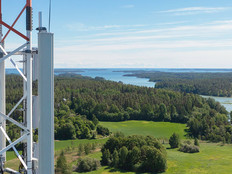Converged Defense Communications
In today’s information age, our military forces’ demand for communications and information services is growing at an exponential pace. Defense missions are now so closely tied to computing and communications that it’s hard to imagine a past where fighters in the field weren’t “plugged in.”
Recognizing how profoundly the warfighter environment has changed, the Defense Information Systems Agency earlier this year published the Campaign Plan 2010, which lays out DISA’s vision for the future of Defense communications and IT. Not surprisingly, the plan cites convergence as a core mission objective, with the goal of providing users in the field a seamless blend of communications, computing and other information-sharing tools to meet the mission at hand.
As Defense agencies mesh communications and IT capabilities, video arguably remains one of the most important tools in the box. Video offers an unmatched platform for users to collaborate meaningfully, to share information and to connect dispersed leadership with operations at the edge. These features have made video conferencing an integral part of today’s mission-critical Defense operations. But, as the Defense vision for communications continues to evolve, video conferencing solutions must also change to meet new requirements.
In addition to convergence, DISA’s plan places high priority on agile communications, improved information sharing at all levels (from command to the front lines), and secure, protected information services and capabilities. At the tactical level, DISA is essentially seeking communications that are mobile, agile and — perhaps most important — secure. DISA’s sharpening focus on each of these elements has moved industry to respond in many ways, giving rise to a next generation of secure video communications solutions designed to meet these goals.
Rough and Ready
Perhaps most notable are ruggedized, deployable video teleconferencing systems that can quickly ship to wherever they’re needed most. In addition to quick transport, these deployable systems expand the reach of command and control leadership, allowing remote chiefs to get closer to the warfighter, as well as other service members and international partners on the front lines. This type of video conferencing is the new communications frontier and quickly becoming a mission-critical capability.
As deployable systems continue to grow in popularity and sophistication, defense users are already starting to demand mobile systems that deliver the same enterprise experience as their command and control counterparts. Today’s deployable units come with a variety of enterprise features and can scale up or down, depending on the requirement. From individual desktop units to deployable video conferencing systems that come with portable projection screens, the approach is to provide systems that can quickly shift from a one-on-one conversation to an auditorium-sized conference call — flexible solutions for an otherwise unpredictable environment.
Today’s systems also must accommodate nontechnical users, allowing them to automatically and securely establish their own VTC calls. That’s a significant advancement over traditional systems, which often require that users schedule VTC calls (sometimes days in advance) and technical staff manage the requests. In a fast-paced warfighter environment, such systems can’t keep pace with the Defense Department’s demand for agility. In reality, most users in the field don’t have an engineering background — and shouldn’t need one — to connect a secure VTC call.
When connecting a secure VTC call, there are hundreds of network and security-level switching processes that must take place — a process that potentially can take hours to complete manually. The nature of DOD’s Global Information Grid further complicates this process, as users often need to connect calls across multiple network types (IP or ISDN) and security levels (classified or unclassified). When time is of the essence, performing this manually is not an option. Secure automation is the key to simplifying these technical systems, making them more accessible to the nontechnical user while upholding rigorous security standards. It’s important to emphasize that in the pursuit of agile and easy-to-use VTC solutions, information assurance must always remain a top priority.
Today, certified VTC solutions are available that can automate the hundreds of necessary network and security switching processes with a flip of a single switch. This approach eliminates countless hours needed to establish conference calls and significantly lessens the learning curve for the typical user.
Share and Share Alike
Through strong partnerships with trusted solution providers, DOD continues to implement innovative new uses of video conferencing to carry out its mission, beyond the obvious goal of increasing conversations between end users. Increasingly, video communications technology is used to support training exercises across the nation, from the command center to field operations. It connects DOD to other government organizations, including law enforcement and intelligence organizations — helping drive informed decision-making; and it is a powerful tool used in collaborative, coalition environments, providing a central platform for DOD and its partners to share mission-critical information.
In such collaborative scenarios, video walls in particular are a growing communications tool used by defense agencies, as well as by homeland security and intelligence organizations. In fact, video walls are a perfect example of a converged communications platform in which video retains its leading role, providing an irreplaceable visual dimension to the converged tool set.
This customized video-conferencing approach lets organizations aggregate and display data from multiple organizations or sources in a variety of formats: computer displays, streaming media, IP camera feeds, surveillance camera feeds, cable network feeds, DVDs and other network-accessible devices. The ability to display information on the command center screen from multiple organizations simultaneously offers a tremendous operational advantage, helping spot trends and patterns in information that might not be discovered otherwise.
According to VB/Research, which focuses on IT, defense and homeland security industries, the video analytics market is expected to exceed $1 billion this year, nearly doubling the forecast for 2009. It’s clear that video communications will continue to play a large role in support of DOD and other government operations. Going forward, it will be exciting to see how DOD employs this technology to collaborate with others more effectively in carrying out its mission. And, equally important, how industry will continue to evolve the technology to meet Defense’s changing needs.







